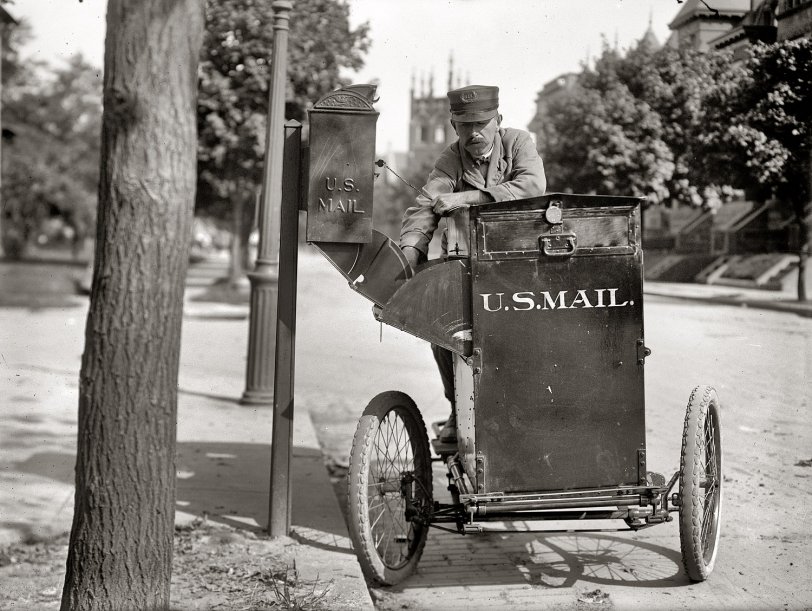


Framed or unframed, desk size to sofa size, printed by us in Arizona and Alabama since 2007. Explore now.
Shorpy is funded by you. Patreon contributors get an ad-free experience.
Learn more.

- Lofty addition
- In 1912
- Keenan Building
- Six years old
- Taken from the P.J. McArdle Roadway?
- It stood only 47 years
- Three track mind
- Incline to the right
- Reach for the sky, 1912 style
- No clean sweep
- Same Job Title, Same Face
- Sadly Lost
- Beautiful ...
- Where you get your kicks
- Aim High
- Pueblo Revival sisters
- Pueblo Neoclassicism
- Milk Man
- Regional dialect.
- Spielberg's inspiration
- Great Photo
- Loaf Story
- Do you still have the Rakes category?
- Could almost be a scene from the 1957 movie 'Hell Drivers'
- The Wages of Fear.
- Conspicuous by their absence
- Got Milk?
- All that aluminum
- No lefties
- Smoke 'em if you've got 'em
Print Emporium
Letterbox: 1912

Washington, D.C. "Post Office Department. Motorcycle postman. 1912." S14 collects the mail. Harris & Ewing Collection glass negative. View full size.
First Street, NW?
Could this picture have been taken on First Street, NW in Bloomingdale? The church in the background looks like Mt. Bethel at Rhode Island Avenue, NW.
"Arrow" key
The lower serial (marked "Street Letter Box" around "United States") lacks the "Mickey Mouse" ears that appear on the cases of later locks. The "Arrow" key was used for locks mounted within the door of a letterbox. It is called an "Arrow" key because it has an arrow marked on the box indicating which edge of the key points down when inserted into the lock. Both of these locks are produced at the same location as they were in 1912, at the Mail Equipment Shops, 2135 Fifth Street, NE, Washington, DC. Another photo on Shorpy shows assembly of the "LA" lock.
Frank R. Scheer
Railway Mail Service Library
Cox Mailbox
I believe the fellow in the photo is likely the John C. Gaither mentioned below: the 'S' in his badge indicates a substitute carrier.
An article earlier in the year anticipates the use of motorcycles to replace horses for the postal service. It states that, at the time, Washington D.C. employed 34 horse-drawn carts collecting mail at an annual cost of $420 each.
I can't find any account of what became of these trials. Samuel C. Cox received patents on this type of letter box in 1910 and 1915.
To Collect Mail Quicker
Trial Route with Motorcycles and Cox
Boxes May Revolutionize Services.Under the direction of Postmaster Merritt the city postoffice will place in operation September 24 and experimental route of mail collection, which if satisfactory may revolutionize this work in all the cities of the country. The experiment contemplates the combined use of motorcycles with the drop-bottom letter box invented by Dr. S. Clifford Cox, of this city.
The motorcycle is equipped with a bin which can be placed under the box, which when unlocked pours the mail in the to bin. The collector merely has to halt his machine for a moment and is not called upon to dismount, as the throwing of the lever causes the box to close up properly.
The route being arranged lies in Bloomingdale and Eckington. It is now being equipped entirely with Cox boxes.
Washington Post, Sep 18, 1912
Mail Man on Motorcycle
New Collection Service from Cox Boxes
Begins Today.It is expected that a motorcycle will be placed in the service of the local Post Office Department today for the collection of mails at Bloomingdale, and if the experiment proves a success after a 60-day trial it is possible that more will be tried out.
John C. Gaither, a substitute carrier, will make the first trials. It is expected that the start would be made yesterday, but on account of bad weather it was postponed.
Thirty-five new boxes, known as the Cox box, have been installed in Bloomingdale. These boxes are arranged near the curb, and have a bottom with a chute. Without getting off his motorcycle the carrier unlocks the box, and is ready for the next.
The motorcycle is specially built for this purpose, and has a single cylinder, five-horsepower engine.
Washington Post, Sep 25, 1912
This is fuel efficiency!
Let's return to this method. Hmmm, I hadn't considered rain, sleet and gloom of night. Never mind.
























On Shorpy:
Today’s Top 5